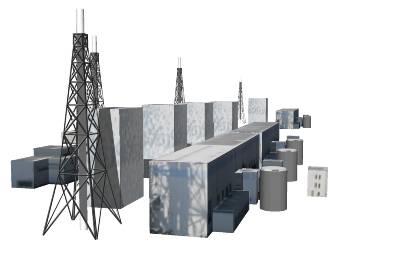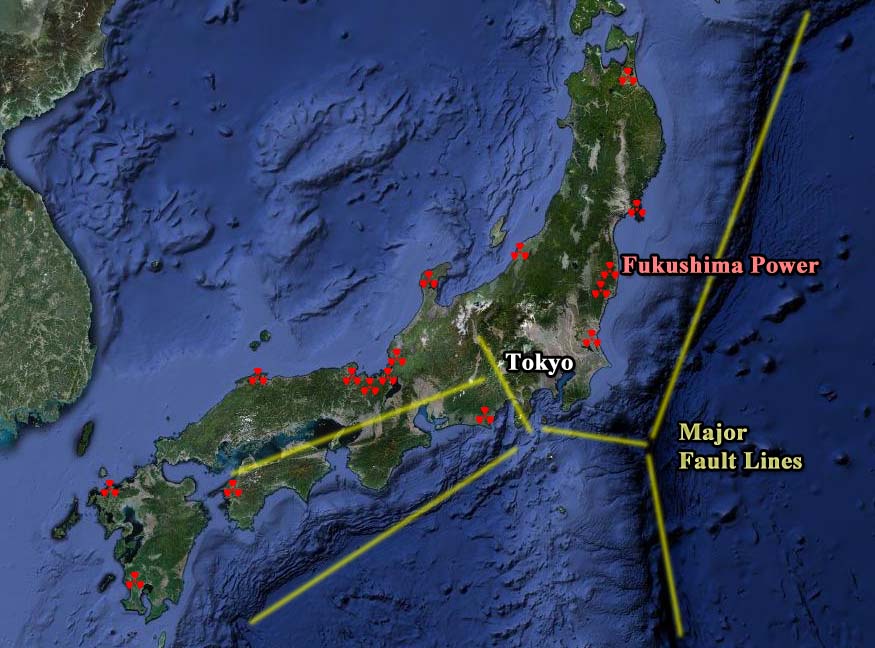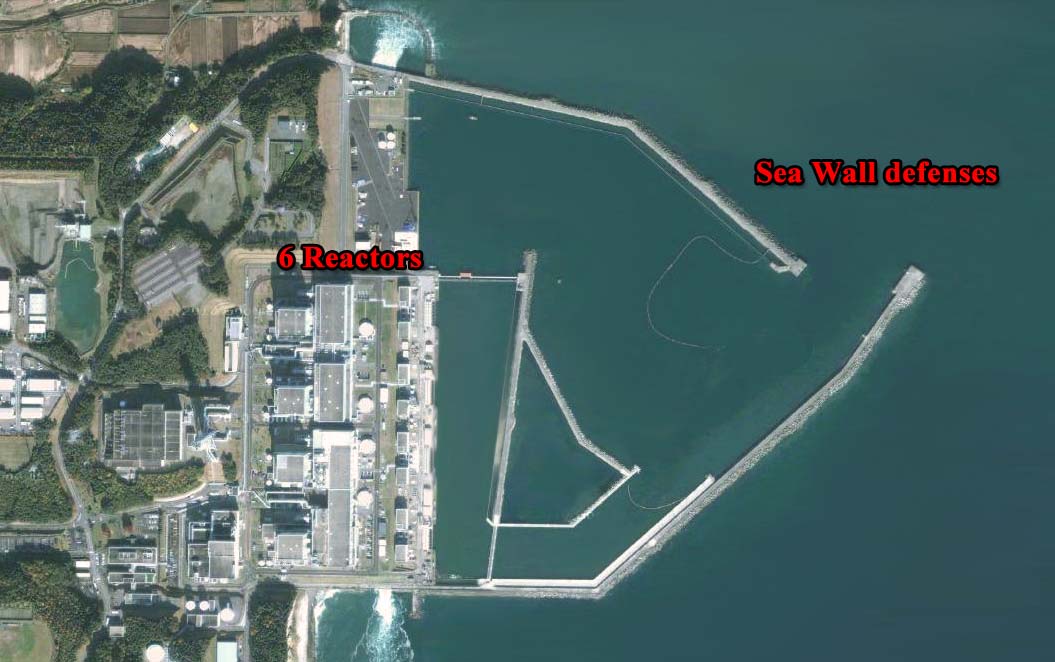The Fukushima I Nuclear Power Plant (Fukushima Dai-ichi in Japanese), is a nuclear power plant located on the Pacific facing, east side of Japan. It was first commissioned in 1967, which means it is pretty old by nuclear power plant standards, on the verge of decommissioning. Thus, design and safety standards would likely not be as high as modern nuclear plants. With six separate generating units located on its site, it has a combined power of 4.7 GW. This is big and makes Fukushima I one of the 15 largest nuclear power stations in the world. By way of reference to other “green” energy projects, it provides the equivalent capacity of the ground-breaking Snowy Hydro Scheme in Australia that took 100,000 people 25 years to make.
Source: Model
The Japan earthquake and subsequent tsunami that hit on March 11, 2011 was the fourth most powerful ever recorded with a magnitude of 9.1, twice more powerful than the initial estimate of 8.9. The plant has suffered major damage from the quake disabling the reactor cooling systems and triggering a widespread evacuation surrounding the plant. Three others that were more powerful since the late 1800s when seismometers started measuring ground motions were in 9.5 in Chile in 1960, 9.2 in Alaska in 1964 and 9.1 in Sumatra in 2004. However, this was still an extraordinarily large quake and resulting tsunami. Neither of which the Fukushima power station was designed to withstand. This may seem a bizarre design-limitation considering the locales geology and the major fault lines that surround the area.
Sources: Nuclear Plant locations, Fault lines, Satellite map
Unit 1 was designed for a quake’s peak ground acceleration of 1.7m/s2. All units were inspected after the 1978 Miyagi earthquake when the ground acceleration was 1.2m/s2, but no damage to the critical parts of the reactor was discovered. However, this month’s Sendai earthquake recorded a ground acceleration of 3.43 m/s2 near the epicenter. Though, the actual measure of ground acceleration at the Fukushima site is not yet known. It is highly likely the earthquake exceeded Fukushima Daiichi’s design strength by a long margin. It is also worth noting, that whether most of the damage was done by the quake or by the Tsunami still remains to be ascertained.
Sources: Satellite map
Japan has been subjected to one other significant nuclear power plant outage due to the vagaries of the Earth in the last 50 years. This is hardly surprising due to the fact that it is situated on a very tectonically active zone. On July 16 2007, Kashiwazaki-Kariwa nuclear power plant, which is on the opposite side of Japan, had to close 3 out of 7 reactors after a 6.8 magnitude quake caused a fire, minor radioactive leaks and dozens of other malfunctions. It is interesting to note that both power stations were only designed to survive much smaller quakes. Questions have to be asked whether Japan’s nuclear power stations have been systematically underspeced with regards to safety. Are they robust enough to survive the somewhat inevitable quakes, and big ones at that? In addition, the sea walls at Fukushima were seen to be grossly negligent with regards to tsunami, wave reflection. They were incapable of withstanding the presumed, 15m wave.
Were the Fukushima and Kashiwazaki-Kariwa nuclear power plants really designed to withstand the outliers in the geological, disaster distribution, a “1 in 1000 year” event? That is rare, very rare, too rare to be reasonably accounted for? Can our engineers be expected to account for them in their design and make a project economically viable? That is a tough question to ask. How long is a piece of string and how rare is unreasonably rare? But, when you take the globe as a whole, these “1 in 1000 year” events occur somewhere quite often. Furthermore, quakes and tsunamis bigger that Fukushima’s have happened before even in Japan and they will happen again. When designing a nuclear power station, should you not raise the bar to account for these seriously unlikely, but still plausible events?
Building nuclear power stations on the coast at a major fault line; Risky business? Was this just a disaster waiting to happen?
Thus, should we ditch nuclear?
Nuclear has its dangers, we can add Fukushima to the 2 previous, famous disasters: Three Mile Island, which contrary to popular perception lead to no deaths, and Chernobyl, constructed in the low-tech, low-maintenance, Soviet era of the ‘70s. All major industrial works are dangerous. India’s Bhopal disaster, at the Union Carbide India Limited pesticide plan, which many of us have forgotten about, was way worse in both its short and long term consequences. If you play with fire, you’ll eventually get burnt. But, if Man never played with fire we would still be living in caves, not planning inter-stellar travel. 14% of the world’s energy comes from nuclear and, in the grand scheme of things, the safety, track record is exemplary and will only get better as designs become intrinsically safer and safer. The Pros and Cons debate of nuclear as a leading, energy source is massive and I’ll leave that for a rainier day. Nevertheless, it’s worth noting that however much Fukushima is a terrible disaster with a death toll of 14,000 and rising, these deaths were by the tsunami, not by the nuclear power station. The co-incidence leads us to believe that there is a causality between the two. This is misinformation. The power station did not cause these deaths. The wave (and/or quake) did destroy the power plant and this particular plant was particularly vulnerable, but that doesn’t mean the technology and concept itself is flawed. You don’t have to paint the whole nuclear picture with the same brush.
Nuclear energy production has a large stigma attached to it, sometimes justified, but much of it is unfounded. It abundantly provides relatively cheap, “green” energy and should not necessarily be disregarded due to often uninformed fears.





I really liked your comments on the recent disaster in Japan and have not seen this kind of commentary on the news.
In fact, what I have been hearing is that all the radio active water that is getting recycled back into the ocean should be of no concern to us. That sounds ridiculous and I wonder how they can say things like this on the news. My question to you is will we be able to eat fish again safely. I live in Seattle and knowing how the trade winds and ocean currents come in our direction, at what point do we need to be careful of our own water and fish contamination. As I recall, doesn’t radio activity last for thousands and thousands of years? Thanks for your response….KH
Hi Karin,
Radiation is natural, it’s all around us and is continuously being emitted from innocuous substances such as granite. Our bodies are used to exposure to it and can, within reason, repair damage from it fairly well.
It’s true radioactive substances can emit for thousands of years (eg Plutonium-239 has a half-life of 24,000 years) or they can last a mere few days (Iodine 131 has a half-life of 8 days). Radiation can cause damage to our cells in extraoridinarily high doses, but has Fukushima released these doses? It’s hard to tell. The Japanese government are in damage control mode and trying to balance public health concerns with saving face. Thus, I don’t believe they’re telling us a very complete story of the potential, radioacitve releases.
However, thinking the worst and the radioactivity is polluting the whole of the massive Pacific’s food chain is superbly unlikely. If this does happen, it won’t be over-night and we will have fair warning of this. U.S scientists are under the cosh, the public eye is on them and they will be testing your fish. If radioacitivity levels rise beyond acceptable levels, you will be told. The fisheries lobby would want a cover-up (naturally), but this is too high profile, I would generally trust their opinion.
Sorry, I can’t give a definitive answer, the debate is on at the moment, so I will sit on the fence, but give, perhaps, a reasonable viewpoint.
Read this good article for more.
Fusion is allot safer i am beginning to learn and it is unsafe to have nuclear plants near the coastlines if it is subject to Earthquakes. I wonder why it hasn’t been capped properly and bunded such that it is closed loop and no waste? One has to wonder what the Neoliberal disaster capitalists role has been in this great devastation to life on Earth?